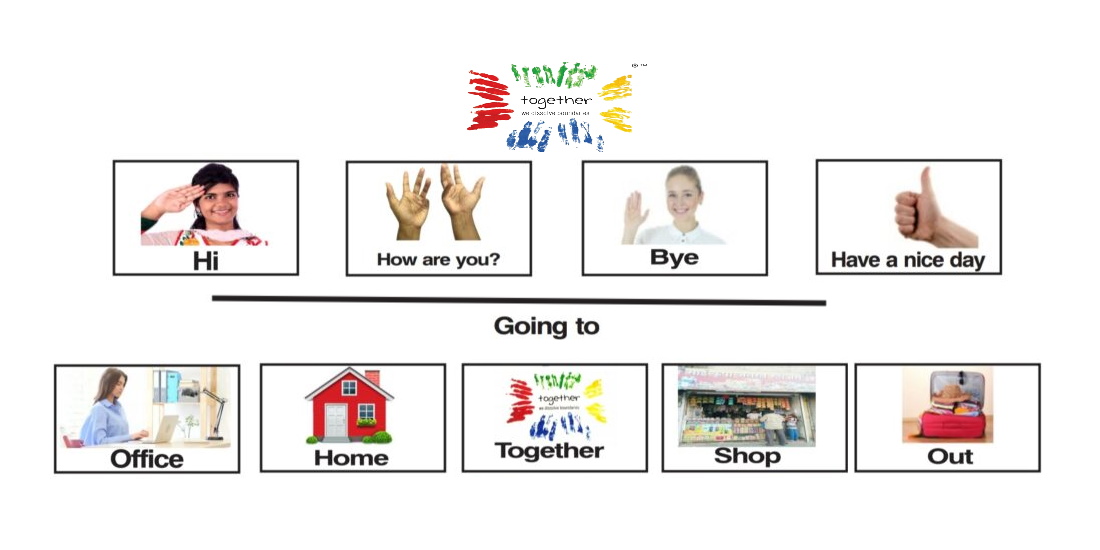Phone Program

Every member of Together Foundation is encourage to carry a phone to the workplace. The phone program helps them to use the phone in thier daily lives. “Phone a friend with autism” is a specilly developed program at Together Foundation that emphasises the right of every individuals to use the phone.
Guidelines
Phone clue cards
Demo videos

Guidelines for Phone Program
No two people with autism have the same communication skill set. Each and every person has to be given a tailor made programme. However there are some underlying principles that have to bear in mind, verbal/limited speech and non verbal requirements.
1. One way is to keep the focus on typical communication that happens between people on the phone. However, many people with autism are wired differently. We have to respect the fact that their idea of a conversation and bonding may be different from others.
These are a few strategies
- Start with video calls, extremely short in duration with simple exchange of greetings between the adult and the caller.
- Ensure that the caller is somebody very well known to the adult, thereby increasing the chances of building rapport. Ideally, the phone conversation must be begun with a parent or sibling or teacher before progressing to relatives, friends and peers.
- Make a phone checklist for the caller and ensure that the person with autism has clue cards to help navigate the conversation.
Ensure plenty of support by the caregiver but avoid repeated instructions ‘Look.. say..look..say’. - Give the adult time to assimilate and respond to the caller.
- At least the first 7 to 10 phone calls must be dedicated to encouraging comfort level with the phone, looking at the caller, establishing basic greeting and goodbye. After this, allow the same questions to be asked but step back as a caregiver and let the adult respond at his/ her own pace.
2. Another way of building great phone communication is to not force the adult to engage in typical speech based communication that puts pressure on the adult.
3. After some initial exchange of greetings, the person on the other side can start engaging in simple stress free activities/online games that allow for a bond to be built naturally.
4. Once rapport has been built over a period of time between the adult and the other person over shared activities, the chances of having a regular conversation on functional topics are likely to be higher.
WhatsApp Video Call

Level 1 : Establishing basic greetings
Steps
| Caller- Teacher | Receiver- Adult |
|
Hi with name of the adult (repeat 2 times) |
Hi with name of the caller |
|
How are you with (sign) (repeat 2 times) |
I am fine (with sign) |
|
I am fine WAIT(repeat 2 times) |
How are you |
|
Where is your mother WAIT (repeat 2 times) |
My mother is _______ (pick the card and show to the caller) |
|
Bye – name WAIT (repeat 2 times) |
Bye |
|
Have a nice day WAIT (repeat 2 times) |
Have a nice day- sign Put of the phone (press on RED button) |
Level 2: Building Comfort Level - Trying for spontaneous conversations
| Caller- Teacher | Receiver- Students |
|
Hi with name of the student WAIT (repeat 2 times) |
Hi with name of the caller |
|
How are you with sign WAIT (repeat 2 times) |
I am fine with sign |
|
I am fine WAIT (repeat 2 times) |
How are you |
|
Have you eaten your breakfast/Lunch? WAIT (repeat 2 times) |
Yes/ No – Sign |
|
What did you eat? WAIT (repeat 2 times) |
Picture of Breakfast/Lunch |
|
Have you come to the center? WAIT (repeat 2 times) |
Yes/ No – Sign |
|
Bye – name, Take care WAIT (repeat 2 times) |
Bye, Take Care |
|
Have a nice day WAIT (repeat 2 times) |
Have a nice day- sign Put of the phone (press on RED button) |
Level 3: Going beyond the center and speaking with parents
- Appointment was setup with the parent to call his/her son/daughter at the center.
- Co-worker would be present along with the adult to help converse with the parent.
- Co-workers prepared a list of questions in advance so that the parents also knew what to ask their children.
- One of the things the parents were encouraged to ask what adult would like to eat after going back home from the center. The parent was asked to offer choices with pictures where required. Parents were also advised to ensure that they actually offered the food that was chosen.
Phone Questions
- Hi (with name of adult)!
- How are you?
- Did you eat your food?
- What work do you like at the centre? (Picture options will be given to the adult)
- Who is your favourite teacher? (options will be given)
- Who is your best friend at the centre? (options will be given)
- What do you want to eat at home? (Parent has to show 2 options)
- I will make ….. for you today
- Ok Bye
Have a good day
Level 4: Phone calls during lockdown
Co-workers started interacting with adults during lockdown period by making video calls 2/3 times a week. The first few phone calls were dedicated to establish the rapport all over again and encouraging the adult to start responding to basic questions. At the next level, games/music were introduced in order to create a bond between the two people. The games and the music that were chosen kept in mind the preferences of the adult.
Level 5: Integrating the phone program with daily living
An experimental project was carried out at Together Foundation with 2 students to help integrate the phone program and make it a part of daily life with peers and family members. Through this documentation, Together Foundation is encouraging parents to help their adults build successful bonds with people around them.
Teaching aids needed for Talktime programme
- Video call on mobile phone.
- Phone must be placed at a height.
- The student must be encouraged to receive the call and end the call. It should not be done by caregiver.
- The work table should be uncluttered.
- Clue cards must be set out neatly.
- At the end of the phone call, the adult must be encouraged to put everything away neatly.
- Build a sense of fun and warmth, give time to the adult to comprehend and answer questions.
- Do not prompt repeatedly.
- Pause and ask a question again.

Phone clue cards

Demo Videos
Phone Program Together – Playlist
- Level 1: Establishing basic greetings
- Level 2: Building Comfort Level – Trying for spontaneous conversations Demo 1
- Level 2: Building Comfort Level – Trying for spontaneous conversations Demo 2
- Level 2: Building Comfort Level – Trying for spontaneous conversations Demo 3
- Level 3: Going beyond the centre and speaking with parents Demo 1
- Level 3 Going beyond the centre and speaking with parents Demo 2
- Level 4: Phone calls during lockdown Demo 1
- Level 4: Phone calls during lockdown Demo 2


